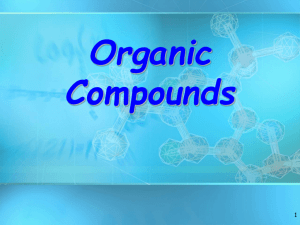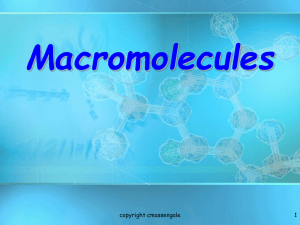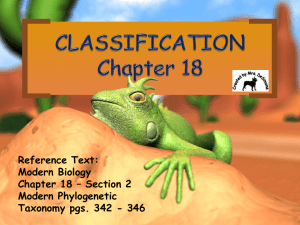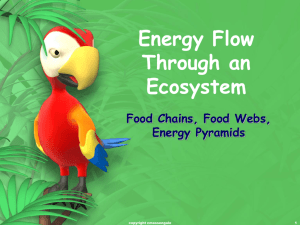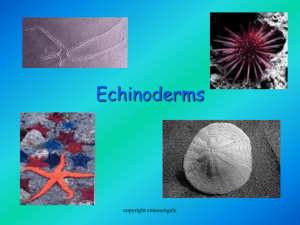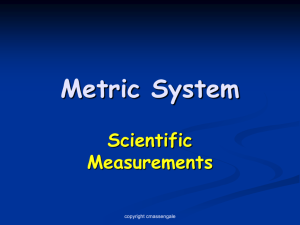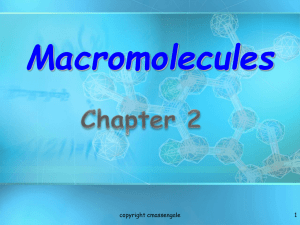Macromolecules
advertisement
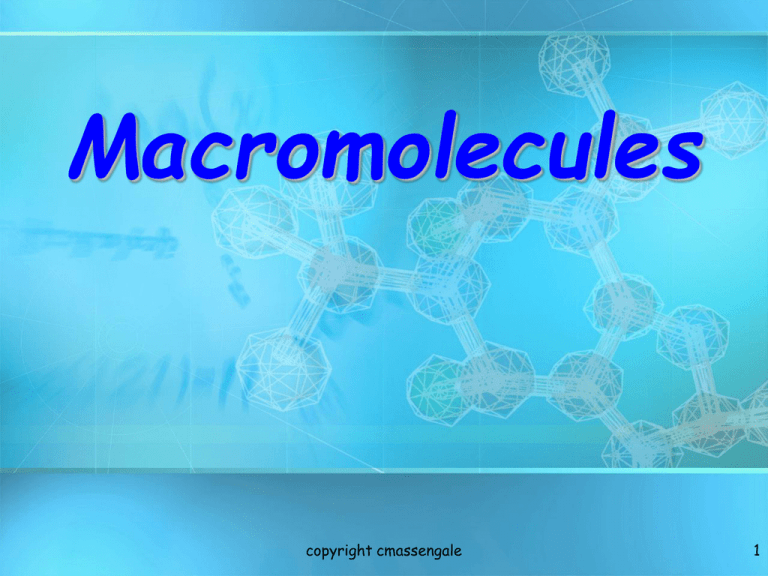
Macromolecules copyright cmassengale 1 DO NOW… • 1) What does CHNOPS stand for? • 2) Is Hydrogen (H) a molecule or an element? • 3) Is Water (H2O) a molecule or an element? • 4) What elements make up carbon dioxide (CO2)? • 5) What elements make up GLUCOSE? copyright cmassengale 2 MACROMOLECULES • Answer the first THREE questions on your notes! • SHARE OUT! copyright cmassengale 3 • ATOMS COMBINE TO MAKE ELEMENTS! • ELEMENTS COMBINE TO MAKE MOLECULES! • WHICH ELEMENTS MAKE UP THE MOLECULE SHOWN? copyright cmassengale 4 CONNECTIONS… What connections do we have to the term “organic compounds”? copyright cmassengale 5 Organic Compounds • Compounds that contain CARBON are called organic. copyright cmassengale 6 Carbon (C) • Carbon can form bonds with as many as 4 other atoms (elements). • Usually with C, H, O or N. PREVIOUS KNOWLEDGE: WHAT ARE THESE ELEMENTS? copyright cmassengale 7 Macromolecules • Macromolecules are large organic molecules made up of smaller molecules! • Examples: THE FOUR MOLECULES OF LIFE? copyright cmassengale 8 Macromolecules • Examples: 1. Carbohydrates 2. Lipids 3. Proteins 4. Nucleic acids (DNA and RNA) copyright cmassengale 9 Carbohydrates copyright cmassengale 10 Carbohydrates Small sugar molecules COMBINE to make large sugar molecules. copyright cmassengale 11 Carbohydrates Monosaccharide: one sugar unit Example: glucose (C6H12O6) glucose copyright cmassengale 12 Carbohydrates Disaccharide: two sugar unit Examples: – Maltose (glucose+glucose) glucose glucose copyright cmassengale 13 BUILD THIS MACROMOLECULE… Voices/Movement: “Restaurant voices,” sitting still Instructions: Using the information from your notes and the pieces of paper in front of you, build a Disaccharide! copyright cmassengale 14 Carbohydrates Polysaccharide: many sugar units Example: cellulose (lettuce, corn) glucose glucose glucose glucose cellulose glucose glucose glucose copyright cmassengale glucose 15 BUILD THIS MACROMOLECULE… Voices/Movement: “Restaurant voices,” sitting still Instructions: Using the information from your notes and the pieces of paper in front of you, build a Polysaccharide! copyright cmassengale 16 Lipids copyright cmassengale 17 Lipids Lipids are FATS! They contain the MOST energy of any macromolecule. • Example: Triglyceride copyright cmassengale 18 Lipids Triglycerides: composed of 1 glycerol and 3 fatty acids. H O H-C----O C-CH2-CH2-CH2-CH2-CH2-CH2-CH2-CH2-CH2-CH3 O H-C----O C-CH2-CH2-CH2-CH2-CH2-CH2-CH2-CH2-CH2-CH3 O fatty acids H-C----O C-CH -CH -CH -CH 2 2 2 H glycerol copyright cmassengale 19 BUILD THIS MACROMOLECULE… Voices/Movement: “Restaurant voices,” sitting still Instructions: Using the information from your notes and the pieces of paper in front of you, build a Triglyceride! copyright cmassengale 20 Proteins copyright cmassengale 21 Proteins (Polypeptides) Proteins are made up of Amino acids bonded together by peptide bonds. copyright cmassengale 22 Primary Structure Amino acids bonded together by peptide bonds (straight chains) Amino Acids (aa) aa1 aa2 aa3 aa4 aa5 aa6 Peptide Bonds copyright cmassengale 23 BUILD THIS MACROMOLECULE… Voices/Movement: “Restaurant voices,” sitting still Instructions: Using the information from your notes and the pieces of paper in front of you, build a Protein! copyright cmassengale 24 Protein Structure Proteins are folded into 3-dimensional shapes that are held together by hydrogen bonds. • Two examples: Alpha Helix Beta Pleated Sheet Hydrogen Bonds copyright cmassengale 25 Nucleic Acids copyright cmassengale 26 Nucleic acids • Two types: a. Deoxyribonucleic acid (DNAdouble helix) b. Ribonucleic acid (RNA-single strand) • Nucleic acids are composed of long chains of nucleotides. copyright cmassengale 27 Nucleic acids • Nucleotides include: 1. phosphate group 2. pentose sugar 3. nitrogen bases: adenine (A) thymine (T) DNA only uracil (U) RNA only cytosine (C) guanine (G) copyright cmassengale 28 BUILD THE FOLLOWING STRUCTURE: Instructions: Using the paper in front of you, scissors and markers, BUILD AND LABEL a nucleic acid! AN IMAGE WILL BE SHOWN ON THE NEXT SLIDE! copyright cmassengale 29 Nucleotide Phosphate Group O O=P-O O 5 CH2 O N C1 C4 Nitrogenous base (A, G, C, or T) Sugar (deoxyribose) C3copyright cmassengale C2 30 5 DNA double helix O 3 3 O P 5 O C G 1 P 5 3 2 4 4 2 3 1 P T 5 A P 3 O O P 5 O 3 copyright cmassengale 5 P 31
